Menu
Download the accompanying materials to this lesson plan - sign up here
Resources and materials for ESL Kids teachers
This fun lesson covers three different objectives: Numbers 1-10 (review), pet vocabulary and using the verb "have" for possession / ownership.
IMPORTANT:
1. You should have already taught the Numbers 1-10 lesson at some point before this lesson - these numbers will be reviewed in this lesson.
2. In American English is it usual to use the structure "Do you have ...?" and "I have ..." when talking about personal possession, however in British English the most common structure is "Have you got ...?" and "I've got ...". In this lesson plan we provide American English structures first, followed by the British English version, shown as (GB: ...). The worksheets, song and reader accompanying this lesson plan come in both American and British English versions.
See our "Warm Up & Wrap Up" page.
1. Review numbers 1-10
You should have taught the Numbers 1-10 lesson at some point before this lesson. Your students will be familiar with the numbers and this is a good time to review and have some numbers fun.
Before class, write each of the numbers 1-10 on cards in marker pen (so you'll have a card with "1" written on it, another with "2", and so on up to "10"). Prepare enough sets so that each group of 3 or 4 students has a set of number cards.
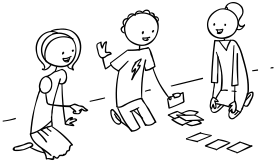 Next, put your students into teams of 3 or 4. Give each group a set of number cards (explained above) and get each group to race putting them in the correct order.
Next, put your students into teams of 3 or 4. Give each group a set of number cards (explained above) and get each group to race putting them in the correct order.2. Teach the vocabulary for pets / animals
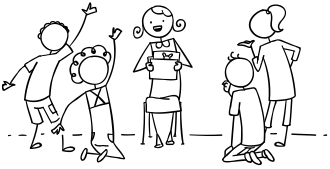 Before class, print off the flashcards for the animals (dog, cat, hamster, rabbit, goldfish, mouse, turtle, parrot, horse, elephant).
Before class, print off the flashcards for the animals (dog, cat, hamster, rabbit, goldfish, mouse, turtle, parrot, horse, elephant).
Your students will probably already know some of the animal vocab (e.g. cat and dog), so rather than just holding up each picture you can play "Flashcard Reveal": take the first flashcard and place it behind the pack of the other cards, so it is hidden from view. Slowly push the flashcard up so that the picture is revealed, bit by bit, to the class.
Encourage everyone to shout out what they think it is until someone gets the right answer. It is ok if students shout out the word in their language if they don't know it – but make sure you teach the English word. Chorus each word three times and stick onto the board.
Once all of the cards are on the board, chorus them one more time. Then point to one picture and elicit the word, then write it clearly under the card.
NOTE: be sure to teach the plural for "mouse" –> "mice".
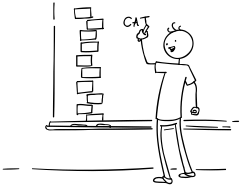 3. Play the "Write vocab on the board race" game
3. Play the "Write vocab on the board race" game
Put the class into teams, so you have 2 to 4 teams in total. Each team selects one person. Teacher shouts out the word for one of the animals on the board and one student from each team must rush up to the board, take a marker or chalk, and write the word (anywhere on the board is ok). The first person to write the word, spelt correctly, wins a point for his/her team. Continue playing until everyone has had a go and all the vocab has been practiced.
4. Teach the structures "Do you have (any) ..." and "I have ..." (GB: "Have you got (any) ..." and "I've got ...")
If you have any photos of your pets (even from years ago) it would be fun to bring them to class – show the photos to the class and as you do use the structure "I have" (GB: I've got) to say what pets you have (e.g. "I have a pet dog" GB: "I've got a pet dog"). If not, no problem, we’ll just use the flashcards instead.
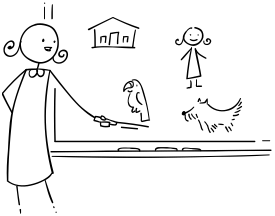 Point to a card and then point to yourself. Say, "I have a pet (dog). His/ Her name is ..." (GB: "I've got a pet (dog). His/ Her name is ..."). Draw a picture on the board of a house, a stick person (you) and the pet (a dog). Point to the stick person and say "This is me". Then point to the house and the animal and say "This is my house", "This is my pet dog, Momo" (for example). Maybe add a few of animals to the picture (e.g. a hamster, a parrot) to get the idea across. The point of this is to make clear that pets are animals we have at home (and not in the zoo, etc.).
Point to a card and then point to yourself. Say, "I have a pet (dog). His/ Her name is ..." (GB: "I've got a pet (dog). His/ Her name is ..."). Draw a picture on the board of a house, a stick person (you) and the pet (a dog). Point to the stick person and say "This is me". Then point to the house and the animal and say "This is my house", "This is my pet dog, Momo" (for example). Maybe add a few of animals to the picture (e.g. a hamster, a parrot) to get the idea across. The point of this is to make clear that pets are animals we have at home (and not in the zoo, etc.).
Each time you add an animal to your picture, ask some students "Do you have pet (dog)?" (GB: "Have you got a pet (dog)?") and elicit "Yes, I do / No, I don't" (GB: "Yes, I have / No, I haven't"). If a student says yes, ask what their pet's name is. Depending on the level of your students, ask some other questions about their pets, such as if they are large or small, colors, favorite food, etc.
Finally, pick out some students at random, choose an animal from the cards on the board, and ask them if they have that pet (e.g. "Do you have a pet mouse" GB: "Have you got a pet mouse"). The elephant is there for fun … don’t be surprised if students say they have one – but look at them disbelievingly!
5. Play "Animal Actions"
In this game students will practice the key structures and vocab.
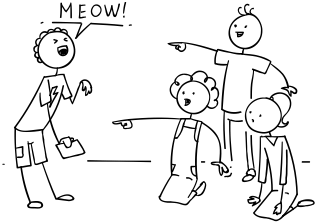 etc.). Then say "Do you have a cat?" (GB: "Have you got a cat?"). If correct, the student holds up the picture so everyone can see and says "Yes, I do" (GB: "Yes, I have"). Then invite members of the audience to ask the other students and guess what animal they have, using the correct structures. It is great fun to see the animal impersonations and to guess what it is!
etc.). Then say "Do you have a cat?" (GB: "Have you got a cat?"). If correct, the student holds up the picture so everyone can see and says "Yes, I do" (GB: "Yes, I have"). Then invite members of the audience to ask the other students and guess what animal they have, using the correct structures. It is great fun to see the animal impersonations and to guess what it is! 6. Sing the "Do you have any Pets?" song (GB: "Have you got any Pets?" song)
Get everyone to stand up. Make sure the flashcards are on the board in the order of the song, or alternatively, use the song poster. As the song is playing, have everyone march on the spot in time with the music and do the actions described below in the gestures section for the song. Play the song 2 or 3 times until everyone has got the hang of it.
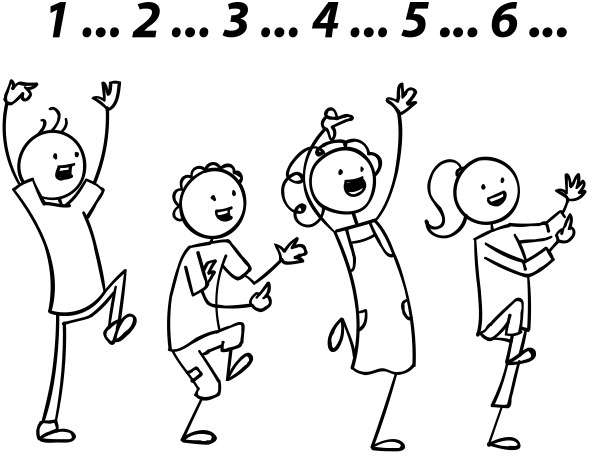 Lyrics for the "Do you have any Pets?" song (US Version)
Lyrics for the "Do you have any Pets?" song (US Version)
Chorus:
Do you, do you, do you
Do you have any pets?
Do you, do you, do you
Do you have any pets?
Yes! Yes!
Verse 1:
I have a dog (a dog!)
I have 2 cats (2 cats!)
I have 3 hamsters (3 hamsters!)
I have 4 rabbits (4 rabbits!)
I have 5 goldfish (5 goldfish!)
Chorus
Verse 2:
I have 6 mice (6 mice!)
I have 7 turtles (7 turtles!)
I have 8 parrots (8 parrots!)
I have 9 horses (9 horses!)
I have 10 elephants! (10 elephants! No way!)
Chorus
Verse 3:
I have
a dog
2 cats
3 hamsters
4 rabbits
5 goldfish
6 mice
7 turtles
8 parrots
9 horses
and 10 elephants!
No way!
Lyrics for the "Have you got any Pets?" song (GB Version)
Chorus:
Have you, have you, have you
Have you got any pets?
Have you, have you, have you
Have you got any pets?
Yes! Yes!
Verse 1:
I've got a dog (a dog!)
I've got 2 cats (2 cats!)
I've got 3 hamsters (3 hamsters!)
I've got 4 rabbits (4 rabbits!)
I've got 5 goldfish (5 goldfish!)
Chorus
Verse 2:
I've got 6 mice (6 mice!)
I've got 7 turtles (7 turtles!)
I've got 8 parrots (8 parrots!)
I've got 9 horses (9 horses!)
I've got 10 elephants! (10 elephants! No way!)
Chorus
Verse 3:
I've got
a dog
2 cats
3 hamsters
4 rabbits
5 goldfish
6 mice
7 turtles
8 parrots
9 horses
and 10 elephants!
No way!
Gestures and activities for the song
The actions are very simple for this song:
- Option 1: hold up your hands (fists closed) and count off the numbers with your fingers as you sing (whilst still marching).
- Option 2: print off the pets flashcards and stick around the classroom walls (in the order of the song). As you sing, point to each animal (whilst still marching).
We also have a video that you can stream in class to sing along with (Internet connection required):
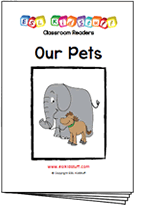 7. Read classroom reader "Our Pets"
7. Read classroom reader "Our Pets"
This reader follows on from the song and also leads nicely onto the next activity as it reinforces the animal vocabulary as well as the structures "Do you have ...?" and "I have..." (GB: "Have you got ...?" and "I've got ...").
Before class, download and print off the reader "Our Pets". As you go through each page elicit each animal and get everybody to guess/speculate which pet each animal has, for example:
Teacher: (on page 1) Look, what animal is this?
Students: Elephant!
Teacher: Yes, well done! ... (reading) ... "Hello, elephant! Do you have any pets?" ... Now, what do you think this is? (pointing at the hidden animal on page 1)
Students: Um ... a dog? ... a horse?
Teacher: Let's see ... (turns to page 2, reading) ... "Yes, I have a pet horse". A horse, very good!
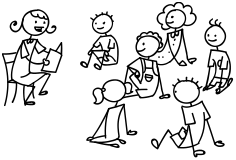 Continue through the story, eliciting the vocab and getting everyone to guess what pet each animal has. Make sure the students are really involved in the story by asking lots of questions (e.g. asking students if they also have the same pets as the animals).
Continue through the story, eliciting the vocab and getting everyone to guess what pet each animal has. Make sure the students are really involved in the story by asking lots of questions (e.g. asking students if they also have the same pets as the animals).
After reading the story, give out a reader worksheet to each student and read through the story one more time (without stopping for questions, etc.) as students draw lines to match the owners to their pets. Then go through the answers as a class.
---
Alternatively, watch our video version of the reader (Internet connection required):
8. Do the "Your Pets Class Survey"
Give out the survey worksheets to each student. Model how to do the first line – by writing in their own names filling in their answers. Then get everyone to mingle and ask as many students as they can about their pets. For students who don't have pets, we have added the "Which new pet would you like?" section, so they have something to answer … everyone can answer this even if they already have pets.
When everyone has finished, tally up on the board the number of pets everyone has to find out which is the most popular pet. Also, find out which new pet most people would like.
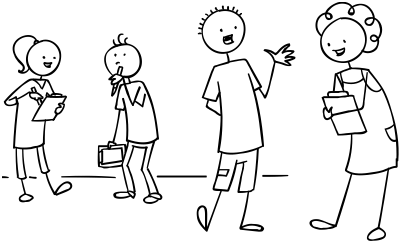
1. Assign Homework: For homework, give out the "My Pet" or "My Dream Pet" worksheets. A good idea is to give our the "My Pet" worksheets to students who have pets and the "My Dream Pet" worksheets to students who don't have any pets. It is worth giving a model answer to this writing task, giving information such as the pet's name, age, size, colors, favorite foods, etc.
2. Wrap up the lesson with some ideas from our "Warm Up & Wrap Up" page.
 Found a mistake?
Found a mistake?
Please let us know
Full access to all resources on ESL KidStuff including lesson plans, flashcards, worksheets, craft sheets,
song downloads, classroom readers, flashcards app and songs app.